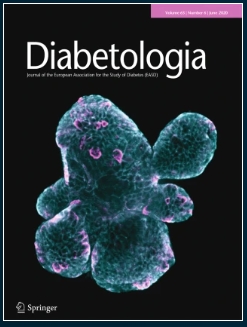胰岛素DEgludec/利拉鲁肽与多次每日胰岛素注射在从医院过渡到门诊管理的持续血糖监测评估:DELI过渡试验
IF 10.2
1区 医学
Q1 ENDOCRINOLOGY & METABOLISM
引用次数: 0
摘要
目的/目的该研究的目的是评估在从医院到门诊的过渡期间,degludec/liraglutide (IDegLira)与每日多次胰岛素注射(MDI)相比的安全性(定义为在随访的前4周至少发生一次低血糖事件(超过15分钟,血糖水平<3.0 mmol/l)的患者百分比)。方法:该研究是一项开放、随机、对照的临床试验,比较了IDegLira和MDI在2型糖尿病患者出院后的疗效。该研究评估了至少发生一次低血糖事件的患者百分比,低血糖事件密度,在范围内的时间(TIR 3.8-10 mmol/l),低于范围的时间(TBR <3.0或<3.8 mmol/l),以及通过连续血糖监测测量的其他血糖管理指标。结果共纳入64例患者,每组32例。他们的基线HbA1c为103±11.6 mmol/mol(11.6±1.7%),年龄为58±12.4岁(mean±SD)。IDegLira组至少发生一次低血糖事件(血糖<3.0 mmol/l)的患者比例低于MDI组(6.2% vs 31.3%;P <0.010),低血糖事件密度(发病率比15.2;95% ci 6.2, 48.2;p<0.001), TBR <3.8 mmol/l (0.9% vs 2.9%;p=0.019), TBR <3.0 mmol/l (0.6% vs 1.3%, p=0.008)。IDegLira组TIR 3.8 ~ 10 mmol/l较高(80.6% vs 69.7%;p = 0.008)。无论基线HbA1c如何,研究结果都是一致的。结论/解释:对于血糖控制欠佳的2型糖尿病患者,ideglira被证明比MDI更安全、更有效,有助于他们从医院转到门诊治疗。资助:本研究由Asociación哥伦比亚糖尿病与代谢协会Endocrinología (ACE)资助。本文章由计算机程序翻译,如有差异,请以英文原文为准。
Insulin DEgludec/LIraglutide versus multiple daily insulin injections in the transition from hospital to outpatient management assessed by continuous glucose monitoring: the DELI transition trial.
AIMS/OBJECTIVE
The aim of the study was to assess the safety profile (defined as the percentage of patients with at least one hypoglycaemic event [more than 15 min with glucose levels <3.0 mmol/l as documented by continuous glucose monitoring] in the first 4 weeks of follow-up) for insulin degludec/liraglutide (IDegLira) compared with multiple daily insulin injections (MDI) during the transition from hospital to an outpatient setting.
METHODS
The study was an open-label, randomised, controlled clinical trial comparing IDegLira to MDI after hospital discharge in patients with type 2 diabetes. The study evaluated the percentage of patients with at least one hypoglycaemic event, the hypoglycaemia event density, the time in range (TIR 3.8-10 mmol/l), the time below range (TBR <3.0 or <3.8 mmol/l), and other glycaemic management metrics measured by continuous glucose monitoring.
RESULTS
Sixty-four patients were included in the analysis (32 in each group). They had a baseline HbA1c of 103 ± 11.6 mmol/mol (11.6 ± 1.7%) and age of 58 ± 12.4 years (means ± SD). The proportion of patients with at least one hypoglycaemic event (plasma glucose <3.0 mmol/l) was lower in the IDegLira group than in the MDI group (6.2% vs 31.3%; p<0.010), as was the hypoglycaemia event density (incidence rate ratio 15.2; 95% CI 6.2, 48.2; p<0.001), TBR <3.8 mmol/l (0.9% vs 2.9%; p=0.019) and TBR <3.0 mmol/l (0.6% vs 1.3%, p=0.008). The TIR 3.8-10 mmol/l was higher in the IDegLira group (80.6% vs 69.7%; p=0.008). The findings were consistent regardless of baseline HbA1c.
CONCLUSIONS/INTERPRETATION
IDegLira proved to be safer and more effective than MDI for individuals with type 2 diabetes who had suboptimal glycaemic control, aiding in their transition from hospital to outpatient care.
TRIAL REGISTRATION
Clinicaltrials.gov NCT05767255 FUNDING: This research was funded by a grant from the Asociación Colombiana de Endocrinología, Diabetes y Metabolismo (ACE).
求助全文
通过发布文献求助,成功后即可免费获取论文全文。
去求助
来源期刊

Diabetologia
医学-内分泌学与代谢
CiteScore
18.10
自引率
2.40%
发文量
193
审稿时长
1 months
期刊介绍:
Diabetologia, the authoritative journal dedicated to diabetes research, holds high visibility through society membership, libraries, and social media. As the official journal of the European Association for the Study of Diabetes, it is ranked in the top quartile of the 2019 JCR Impact Factors in the Endocrinology & Metabolism category. The journal boasts dedicated and expert editorial teams committed to supporting authors throughout the peer review process.
 求助内容:
求助内容: 应助结果提醒方式:
应助结果提醒方式:


